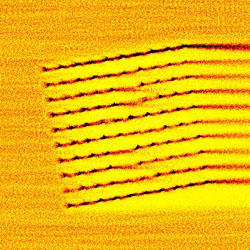Lightly Filtered
You might expect small particles to bounce around aimlessly when forced through a regularly spaced grid of obstacles. But the 16 September print issue of PRL reports instead that colloidal particles become locked into specific paths when flowing through a Pachinko-like array of laser beams. Researchers say this result could form the basis of a technology to sort colloids or biological molecules.
When particles are forced across a bumpy surface–one riddled with an evenly spread series of depressions–they can follow either the driving force or a particular trail of bumps, according to numerical studies. The second choice is only apparent when the alignment of bumps and the flow direction are at a slight angle to each other. Quantum mechanical systems where particles move across a “washboard potential,” such as electrons moving across waves of charge density, can theoretically display a preference for certain paths, called kinetically locked-in states. But no one has ever seen either the classical or quantum versions directly.
So David Grier and his associates at the University of Chicago decided to set up a similar system where the particles could be observed. They created a 20-micron thick layer of water between two glass plates and forced 1.5-micron silica spheres through this layer and across a ten-by-ten array of optical tweezers. These tweezers are strongly focused laser beams capable of tugging on small objects, so each one acts as a little valley for the particles. They made the array by splitting laser light into many beams, using a technique they have developed over recent years. A digital video camera attached to a microscope recorded the motions of the silica particles in the fluid.
Grier and his colleagues showed that the particles prefer traveling down rows of traps, rather than following the water flow, as long as the flow and the array are aligned to within about 10 or 15 degrees. Beyond that critical angle, the particles lock into a different path or none at all. But even when deflected along the array, the beads do not migrate in straight lines. “They’re doing it in a scrambly way, and yet on average they’re going in the direction the potential energy landscape tells them to,” says Grier. “That’s weird.”
Because the array preferentially deflects particles of a particular diameter–depending on the laser wavelength–Grier says the technique could be used to sort objects by size. With other modifications the system could sort by refractive index or charge. One potential application, he says, could be to segregate biomolecules or cells without dyes or fluorescent tags.
The group presents “stunning, direct-visualization results” of an effect of which there was only indirect experimental evidence before, says Franco Nori of the University of Michigan in Ann Arbor. Many have been expecting such a demonstration for a while now, he adds. David Weitz of Harvard University notes that existing technologies have trouble distinguishing colloidal particles that differ in size by just 20 percent. In contrast, he says, “this [method] looks like a fairly straightforward way” of sorting such objects.
–JR Minkel
JR Minkel is a freelance science writer in New York City.



